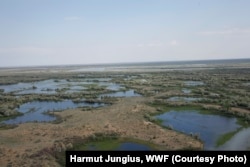The Caspian tiger, one of the biggest cats that ever lived, roamed sparse forest habitats and riverine corridors from Turkey to northwestern China before it was killed off by humans in the second half of the 20th century.
Plans to reintroduce tigers to Central Asia, using the Amur tiger from Russia, have been a topic of discussion for about a decade.
But the idea got a scientific boost earlier this month when a study published in Biological Conservation laid out the options for restoring tigers to that region and identified a "promising site" in Kazakhstan that could support nearly 100 wild tigers within 50 years.
Officials from the conservation group WWF say they hope to sign an agreement with the Kazakh government this year that would pave the way for the implementation of a tiger-restoration program. But they also warn that it could take years before important challenges are adequately addressed and big cats start roaming the area again.
"It's a long-term project. Our model just showed that it can require up to 50 years for reintroducing tigers," says Mikhail Paltsyn, who oversaw analytical aspects of the study, by researchers from WWF and the College of Environmental Science and Forestry (ESF) in Syracuse, New York.
The Caspian tiger, a fierce predator that can be up to 3 meters long and weigh more than 140 kilograms, was last seen in the wild in the early 1970s and there are none in captivity, according to the International Union for Conservation of Nature and Natural Resources (IUCN).
Returning tigers to Central Asia would involve using the Amur tiger from the Russian Far East, a subspecies that is nearly identical genetically to the extinct Caspian tiger.
"The Caspian tiger formerly populated quite a huge area, about 13 countries," says Paltsyn, an ESF doctoral candidate. "But in the middle of the 20th century it gradually disappeared from all the habitat because of extermination, habitat degradation, and prey degradation."
In the former Soviet Union, the tigers' disappearance was accelerated by bounties paid until the 1930s to promote the poisoning and trapping of the animals.
Meanwhile, a critical tiger habitat -- the tugai, a riparian ecosystem of trees, shrubs, and wetlands that occurs in semiarid and desert climates -- vanished as a result of massive agricultural and irrigation projects, leading to the disappearance of the cats' quarry.
The new study identified two habitat patches in western Kazakhstan that are potentially suitable for their establishment: the Ili River delta and the adjacent southern coast of Balkhash Lake.
It suggested that the 7,000-square-kilometer area could support a population of between 64 and 98 tigers within half a century if 40 to 55 tigers are introduced.
Paltsyn says the area is "only slightly degraded" and still has "considerable cover of tugai woodlands and reed-thicket ecosystem, the same ecosystem the tigers populated until the end of the 1950s" as well as a "low population density" of fewer than two people per square kilometer.
The area also has animals that tigers might typically prey on -- wild boar, Bukhara deer, and roe deer -- although their populations are "low due to poaching," he adds.
As a result, prey populations would need to be brought up to "sustainable levels," a process that Paltsyn says could take from five to 15 years.
Other challenges include ending uncontrolled fires set by local herders looking to turn the landscape into pastures, and addressing human safety and socioeconomic benefits for local populations to provide a sustainable future for both tigers and people.
Kazakhstan and China would also need to agree on regulating water consumption from the Ili River in order to maintain sufficient water levels in Balkash Lake for riparian ecosystems, conservationists say.
WWF and Kazakh government officials have been working for years on a tiger-restoration plan, but it has been delayed since the country's budget was hit hard by falling oil prices and the impact of Russia's economic crisis.
WWF-Russia director Igor Chestin, who was also involved in the latest study, says Kazakhstan appears to be ready to commit to the program, adding that top Kazakh officials were "very enthusiastic" about it during a meeting with WWF officials last year.
He says WWF hopes to reach an agreement with the government as early as this year and attract $20 million from donors over 10 years for the project's implementation, but funding from Astana will also be needed.
"The first thing to start the program is to establish a [protected] national reserve," he says. "It has been designed, planned, and it's actually waiting for the approval of the Kazakh government. So I hope that the reserve will be formally established this year or very early next year. This will mark the real start of the program."
Chestin also says Russian President Vladimir Putin expressed readiness last year to provide Amur tigers for the reintroduction program, but only if scientists confirm it won't harm the tiger population in Russia.
The number of Amur tigers in the Russian Far East has increased in recent decades, with up to 540 animals estimated to be living in the wild there.
The study says that moving some of them to Kazakhstan could be enough to eventually establish a wild population without harming the Russian population.
Chestin insists that the program would primarily use orphaned tigers that are being kept at a rehabilitation and reintroduction center in the Primorsky region.












